Amikacin-Loaded Chitosan Hydrogel Film Cross-Linked with Folic Acid for Wound Healing Application
Abstract
1. Introduction
2. Results and Discussion
2.1. Determination of Drug Entrapment Efficiency
2.2. Physicochemical Characterization
2.3. SEM and Investigation of Surface Roughness by AFM
2.4. Fourier Transform Infrared Spectroscopy
2.5. Thermal Analysis
2.6. Powder X-ray Diffraction Analysis
2.7. Determination of Gel%, Yield% and Gel Time
2.8. Swelling Study
2.9. Drug Release Study
2.10. Hemolysis Assay
2.11. Cytotoxicity Study
2.12. Microbial Penetration
2.13. Antimicrobial Study
2.14. Primary Skin Irritation Study of Hydrogel Film
2.15. Stability Studies
3. Conclusions
4. Materials and Methods
4.1. Chemicals
4.2. Synthesis
4.3. Physical Characterization
4.4. Determination of Drug Entrapment Efficiency
4.5. Scanning Electron Microscopy and Atomic Force Microscopy
4.6. Fourier Transform Infrared Spectroscopy
4.7. Thermal Analysis
4.8. Powder X-ray Diffraction
4.9. Determination of Gel%, Yield% and Gel Time
4.10. Swelling Study
4.11. Release Study
4.12. Hemolytic Investigations
4.13. Microbial Limit Test
4.14. Cell Culture
4.15. Cell Viability Assay
4.16. Antimicrobial Study
4.17. Skin Irritation Test
4.18. Stability Study
4.19. Analytical Statistics
Author Contributions
Funding
Institutional Review Board Statement
Informed Consent Statement
Data Availability Statement
Acknowledgments
Conflicts of Interest
References
- Rahimi, M.; Noruzi, E.B.; Sheykhsaran, E.; Ebadi, B.; Kariminezhad, Z.; Molaparast, M.; Mehrabani, M.G.; Mehramouz, B.; Yousefi, M.; Ahmadi, R.; et al. Carbohydrate polymer-based silver nanocomposites: Recent progress in the antimicrobial wound dressings. Carbohydr. Polym. 2020, 231, 115696. [Google Scholar] [CrossRef]
- Nezhad-Mokhtari, P.; Javanbakht, S.; Asadi, N.; Ghorbani, M.; Milani, M.; Hanifehpour, Y.; Gholizadeh, P.; Akbarzadeh, A. Recent advances in honey-based hydrogels for wound healing applications: Towards natural therapeutics. J. Drug Deliv. Sci. Technol. 2021, 66, 102789. [Google Scholar] [CrossRef]
- Wenzel, R.; Perl, T. The significance of nasal carriage of Staphylococcus aureus and the incidence of postoperative wound infection. J. Hosp. Infect. 1995, 31, 13–24. [Google Scholar] [CrossRef] [PubMed]
- Anirudhan, T.S.; Divya, P.L.; Nima, J. Synthesis and characterization of novel drug delivery system using modified chitosan based hydrogel grafted with cyclodextrin. Chem. Eng. J. 2016, 284, 1259–1269. [Google Scholar] [CrossRef]
- Yadav, H.; Al Halabi, N.; Alsalloum, G. Nanogels as novel drug delivery systems—A review. J. Pharm. Pharm. Res. 2017, 1, 1–8. [Google Scholar]
- Sharpe, L.A.; Vela Ramirez, J.E.; Haddadin, O.M.; Ross, K.A.; Narasimhan, B.; Peppas, N.A. pH-responsive microencapsulation systems for the oral delivery of polyanhydride nanoparticles. Biomacromolecules 2018, 19, 793–802. [Google Scholar] [CrossRef] [PubMed]
- Aycan, D.; Alemdar, N. Development of pH-responsive chitosan-based hydrogel modified with bone ash for controlled release of amoxicillin. Carbohydr. Polym. 2018, 184, 401–407. [Google Scholar] [CrossRef]
- Mohebbi, S.; Nezhad, M.N.; Zarrintaj, P.; Jafari, S.H.; Gholizadeh, S.S.; Saeb, M.R.; Mozafari, M. Chitosan in biomedical engineering: A critical review. Curr. Stem Cell Res. Ther. 2019, 14, 93–116. [Google Scholar] [CrossRef]
- Reis, R.G.d.; Tedesco, A.C.; Curylofo-Zotti, F.A.; Cortez, T.V.; Borges, H.S.; Souza-Gabriel, A.E.; Corona, S.A.M. Longitudinal analyses of composite resin restoration on erosive lesions: Effect of dentin treatment with a chitosan nanoformulation containing green tea. Braz. J. Oral Sci. 2023, 22, e236839. [Google Scholar] [CrossRef]
- Ahmed, F.; Soliman, F.M.; Adly, M.A.; Soliman, H.A.M.; El-Matbouli, M.; Saleh, M. Recent progress in biomedical applications of chitosan and its nanocomposites in aquaculture: A review. Res. Vet. Sci. 2019, 126, 68–82. [Google Scholar] [CrossRef]
- Ryu, J.H.; Hong, S.; Lee, H. Bio-inspired adhesive catechol-conjugated chitosan for biomedical applications: A mini review. Acta Biomater. 2015, 27, 101–115. [Google Scholar] [CrossRef]
- Kazeminava, F.; Javanbakht, S.; Nouri, M.; Gholizadeh, P.; Nezhad-Mokhtari, P.; Ganbarov, K.; Tanomand, A.; Kafil, H.S. Gentamicin-loaded chitosan/folic acid-based carbon quantum dots nanocomposite hydrogel films as potential antimicrobial wound dressing. J. Biol. Eng. 2022, 16, 36. [Google Scholar] [CrossRef]
- Pellá, M.C.; Lima-Tenório, M.K.; Tenório-Neto, E.T.; Guilherme, M.R.; Muniz, E.C.; Rubira, A.F. Chitosan-based hydrogels: From preparation to biomedical applications. Carbohydr. Polym. 2018, 196, 233–245. [Google Scholar] [CrossRef]
- Salari, M.; Khiabani, M.S.; Mokarram, R.R.; Ghanbarzadeh, B.; Kafil, H.S. Use of gamma irradiation technology for modification of bacterial cellulose nanocrystals/chitosan nanocomposite film. Carbohydr. Polym. 2021, 253, 117144. [Google Scholar] [CrossRef]
- Ebrahimzadeh, S.; Bari, M.R.; Hamishehkar, H.; Kafil, H.S.; Lim, L.-T. Essential oils-loaded electrospun chitosan-poly (vinyl alcohol) nonwovens laminated on chitosan film as bilayer bioactive edible films. LWT 2021, 144, 111217. [Google Scholar] [CrossRef]
- Peters, J.T.; Wechsler, M.E.; Peppas, N.A. Advanced biomedical hydrogels: Molecular architecture and its impact on medical applications. Regen. Biomater. 2021, 8, rbab060. [Google Scholar] [CrossRef]
- Mndlovu, H.; du Toit, L.C.; Kumar, P.; Choonara, Y.E.; Marimuthu, T.; Kondiah, P.P.; Pillay, V. Bioplatform fabrication approaches affecting chitosan-based interpolymer complex properties and performance as wound dressings. Molecules 2020, 25, 222. [Google Scholar] [CrossRef]
- Murugesan, S.; Scheibel, T. Chitosan-based nanocomposites for medical applications. J. Polym. Sci. 2021, 59, 1610–1642. [Google Scholar] [CrossRef]
- Smith, A.D.; Kim, Y.-I.; Refsum, H. Is folic acid good for everyone? Am. J. Clin. Nutr. 2008, 87, 517–533. [Google Scholar] [CrossRef]
- Bessa, L.J.; Fazii, P.; Di Giulio, M.; Cellini, L. Bacterial isolates from infected wounds and their antibiotic susceptibility pattern: Some remarks about wound infection. Int. Wound J. 2015, 12, 47–52. [Google Scholar] [CrossRef]
- Haley, R.W.; Schaberg, D.R.; Crossley, K.B.; Von Allmen, S.D.; McGowan, J.E. Extra charges and prolongation of stay attributable to nosocomial infections: A prospective interhospital comparison. Am. J. Med. 1981, 70, 51–58. [Google Scholar] [CrossRef]
- Farjadian, F.; Akbarizadeh, A.R.; Tayebi, L. Synthesis of novel reducing agent for formation of metronidazole-capped silver nanoparticle and evaluating antibacterial efficiency in gram-positive and gram-negative bacteria. Heliyon 2020, 6, e04747. [Google Scholar] [CrossRef]
- Roehrborn, A.A.; Hansbrough, J.F.; Gualdoni, B.; Kim, S. Lipid-based slow-release formulation of amikacin sulfate reduces foreign body-associated infections in mice. Antimicrob. Agents Chemother. 1995, 39, 1752–1755. [Google Scholar] [CrossRef]
- Barkat, K.; Ahmad, M.; Minhas, M.U.; Khalid, I. Oxaliplatin-loaded crosslinked polymeric network of chondroitin sulfate-co-poly (methacrylic acid) for colorectal cancer: Its toxicological evaluation. J. Appl. Polym. Sci. 2017, 134, 45312. [Google Scholar] [CrossRef]
- Glinka, M.; Filatova, K.; Kucińska-Lipka, J.; Bergerova, E.D.; Wasik, A.; Sedlařík, V. Encapsulation of Amikacin into Microparticles Based on Low-Molecular-Weight Poly (lactic acid) and Poly (lactic acid-co-polyethylene glycol). Mol. Pharm. 2021, 18, 2986–2996. [Google Scholar] [CrossRef]
- Wang, T.; Chen, L.; Shen, T.; Wu, D. Preparation and properties of a novel thermo-sensitive hydrogel based on chitosan/hydroxypropyl methylcellulose/glycerol. Int. J. Biol. Macromol. 2016, 93, 775–782. [Google Scholar] [CrossRef]
- Kumar, A.; Lahiri, S.S.; Singh, H. Development of PEGDMA: MAA based hydrogel microparticles for oral insulin delivery. Int. J. Pharm. 2006, 323, 117–124. [Google Scholar] [CrossRef]
- Badhe, R.V.; Bijukumar, D.; Chejara, D.R.; Mabrouk, M.; Choonara, Y.E.; Kumar, P.; du Toit, L.C.; Kondiah, P.P.; Pillay, V. A composite chitosan-gelatin bi-layered, biomimetic macroporous scaffold for blood vessel tissue engineering. Carbohydr. Polym. 2017, 157, 1215–1225. [Google Scholar] [CrossRef]
- Syed, R.U.; Moni, S.S.; Nawaz, M.; Bin Break, M.K.; Khalifa, N.E.; Abdelwahab, S.I.; Alharbi, R.M.; Alfaisal, R.H.; Al Basher, B.N.; Alhaidan, E.M. Formulation and Evaluation of Amikacin Sulfate Loaded Dextran Nanoparticles against Human Pathogenic Bacteria. Pharmaceutics 2023, 15, 1082. [Google Scholar] [CrossRef]
- Samanta, H.S.; Ray, S.K. Synthesis, characterization, swelling and drug release behavior of semi-interpenetrating network hydrogels of sodium alginate and polyacrylamide. Carbohydr. Polym. 2014, 99, 666–678. [Google Scholar] [CrossRef]
- Bashir, S.; Teo, Y.Y.; Ramesh, S.; Ramesh, K. Synthesis, characterization, properties of N-succinyl chitosan-g-poly (methacrylic acid) hydrogels and in vitro release of theophylline. Polymer 2016, 92, 36–49. [Google Scholar] [CrossRef]
- Ganji, F.; Abdekhodaie, M.J.; Ramazani SA, A. Gelation time and degradation rate of chitosan-based injectable hydrogel. J. Sol-Gel Sci. Technol. 2007, 42, 47–53. [Google Scholar] [CrossRef]
- Nagpal, M.; Aggarwal, G.; Jain, U.K.; Madan, J. Extraction of gum from Abelmoschus esculentus: Physicochemical peculiarity and antioxidant prepatent. Asian J. Pharm. Clin. Res. 2017, 10, 174. [Google Scholar] [CrossRef]
- Rudnic, E.; Kanig, J.; Rhodes, C. Effect of molecular structure variation on the disintegrant action of sodium starch glycolate. J. Pharm. Sci. 1985, 74, 647–650. [Google Scholar] [CrossRef] [PubMed]
- Rojas, J.; Guisao, S.; Ruge, V. Functional assessment of four types of disintegrants and their effect on the spironolactone release properties. AAPS Pharmscitech. 2012, 13, 1054–1062. [Google Scholar] [CrossRef]
- Zaharuddin, N.D.; Noordin, M.I.; Kadivar, A. The use of hibiscus esculentus (Okra) gum in sustaining the release of propranolol hydrochloride in a solid oral dosage form. BioMed Res. Int. 2014, 2014, 735891. [Google Scholar] [CrossRef]
- Anirudhan, T.S.; Mohan, A.M. Novel pH sensitive dual drug loaded-gelatin methacrylate/methacrylic acid hydrogel for the controlled release of antibiotics. Int. J. Biol. Macromol. 2018, 110, 167–178. [Google Scholar] [CrossRef]
- Mehmood, Y.; Ullah, K.I.; Shahzad, Y. Mesoporous Silica Nanoparticles-Based Bilayer Tablets: A New Strategy for Co-delivery of Velpatasvir and Sofosbuvir. Lat. Am. J. Pharm. 2022, 41, 1–36. [Google Scholar]
- Mehmood, Y.; Khan, I.U.; Shahzad, Y.; Khalid, S.H.; Asghar, S.; Irfan, M.; Asif, M.; Khalid, I.; Yousaf, A.M.; Hussain, T. Facile synthesis of mesoporous silica nanoparticles using modified sol-gel method: Optimization and in vitro cytotoxicity studies. Pak. J. Pharm. Sci. 2019, 32, 1805–1812. [Google Scholar]
- Fu, G.; Soboyejo, W. Swelling and diffusion characteristics of modified poly (N-isopropylacrylamide) hydrogels. Mater. Sci. Eng. C 2010, 30, 8–13. [Google Scholar] [CrossRef]
- Ahmadi, F.; Oveisi, Z.; Samani, S.M.; Amoozgar, Z. Chitosan based hydrogels: Characteristics and pharmaceutical applications. Res. Pharm. Sci. 2015, 10, 1. [Google Scholar]
- Nemes, D.; Kovács, R.; Nagy, F.; Mező, M.; Poczok, N.; Ujhelyi, Z.; Pető, Á.; Fehér, P.; Fenyvesi, F.; Váradi, J.; et al. Interaction between different pharmaceutical excipients in liquid dosage forms—Assessment of cytotoxicity and antimicrobial activity. Molecules 2018, 23, 1827. [Google Scholar] [CrossRef]
- Liu, H.; Li, Z.; Sun, Y.; Geng, X.; Hu, Y.; Meng, H.; Ge, J.; Qu, L. Synthesis of luminescent carbon dots with ultrahigh quantum yield and inherent folate receptor-positive cancer cell targetability. Sci. Rep. 2018, 8, 1086. [Google Scholar] [CrossRef]
- Park, J.-S.; An, S.-J.; Jeong, S.-I.; Gwon, H.-J.; Lim, Y.-M.; Nho, Y.-C. Chestnut honey impregnated carboxymethyl cellulose hydrogel for diabetic ulcer healing. Polymers 2017, 9, 248. [Google Scholar] [CrossRef]
- Koosha, M.; Hamedi, S. Intelligent Chitosan/PVA nanocomposite films containing black carrot anthocyanin and bentonite nanoclays with improved mechanical, thermal and antibacterial properties. Prog. Org. Coat. 2019, 127, 338–347. [Google Scholar] [CrossRef]
- Muxika, A.; Uranga, J.; Etxabide, A.; Guerrero, P.; de la Caba, K. Chitosan as a bioactive polymer: Processing, properties and applications. Int. J. Biol. Macromol. 2017, 105, 1358–1368. [Google Scholar] [CrossRef]
- Roy, S.; Rhim, J.-W. Carboxymethyl cellulose-based antioxidant and antimicrobial active packaging film incorporated with curcumin and zinc oxide. Int. J. Biol. Macromol. 2020, 148, 666–676. [Google Scholar] [CrossRef]
- Patel, S.; Srivastava, S.; Singh, M.R.; Singh, D. Preparation and optimization of chitosan-gelatin films for sustained delivery of lupeol for wound healing. Int. J. Biol. Macromol. 2018, 107, 1888–1897. [Google Scholar] [CrossRef]
- Thakur, G.; Singh, A.; Singh, I. Formulation and evaluation of transdermal composite films of chitosan-montmorillonite for the delivery of curcumin. Int. J. Pharm. Investig. 2016, 6, 23. [Google Scholar]
- Korany, M.A.-T.; Haggag, R.S.; Ragab, M.A.; Elmallah, O.A. Liquid chromatographic determination of amikacin sulphate after pre-column derivatization. J. Chromatogr. Sci. 2014, 52, 837–847. [Google Scholar] [CrossRef]
- Anwar, M.; Pervaiz, F.; Shoukat, H.; Noreen, S.; Shabbir, K.; Majeed, A.; Ijaz, S. Formulation and evaluation of interpenetrating network of xanthan gum and polyvinylpyrrolidone as a hydrophilic matrix for controlled drug delivery system. Polym. Bull. 2020, 78, 59–80. [Google Scholar] [CrossRef]
- Dutta, S.; Samanta, P.; Dhara, D. Temperature, pH and redox responsive cellulose based hydrogels for protein delivery. Int. J. Biol. Macromol. 2016, 87, 92–100. [Google Scholar] [CrossRef] [PubMed]
- Kamoun, E.A. N-succinyl chitosan–dialdehyde starch hybrid hydrogels for biomedical applications. J. Adv. Res. 2016, 7, 69–77. [Google Scholar] [CrossRef] [PubMed]
- Acharjya, S.K.; Mallick, P.; Panda, P.; Kumar, K.R.; Annapurna, M.M. Spectrophotometric methods for the determination of letrozole in bulk and pharmaceutical dosage forms. J. Adv. Pharm. Technol. Res. 2010, 1, 348. [Google Scholar] [CrossRef] [PubMed]
- Mehmood, Y.; Khan, I.U.; Shahzad, Y.; Khan, R.U.; Khalid, S.H.; Yousaf, A.M.; Hussain, T.; Asghar, S.; Khalid, I.; Asif, M.; et al. Amino-decorated mesoporous silica nanoparticles for controlled sofosbuvir delivery. Eur. J. Pharm. Sci. 2020, 143, 105184. [Google Scholar] [CrossRef]
- Rusu, A.G.; Popa, M.I.; Lisa, G.; Vereştiuc, L. Thermal behavior of hydrophobically modified hydrogels using TGA/FTIR/MS analysis technique. Thermochim. Acta 2015, 613, 28–40. [Google Scholar] [CrossRef]
- MehMehmood, Y.; Khan, I.U.; Shahzad, Y.; Khan, R.U.; Iqbal, M.S.; Khan, H.A.; Khalid, I.; Yousaf, A.M.; Khalid, S.H.; Asghar, S.; et al. In-vitro and in-vivo evaluation of velpatasvir-loaded mesoporous silica scaffolds. A prospective carrier for drug bioavailability enhancement. Pharmaceutics 2020, 12, 307. [Google Scholar] [CrossRef]
- Mehmood, Y.; Shahid, H.; Barkat, K.; Ibraheem, M.; Riaz, H.; Badshah, S.F.; Chopra, H.; Sharma, R.; Nepovimova, E.; Kuca, K.; et al. Designing of SiO2 Mesoporous-Nanoparticles Loaded with Mometasone Furoate for Potential Nasal Drug Delivery: Ex Vivo Evaluation and Determination of Pro-inflammatory Interferon and Interleukins mRNA Expression. Front. Cell Dev. Biol. 2023, 10, 2411. [Google Scholar] [CrossRef] [PubMed]
- Mehmood, Y.; Shahid, H.; Rashid, A.; Alhamhoom, Y.; Kazi, M. Developing of SiO2 Nanoshells Loaded with Fluticasone Propionate for Potential Nasal Drug Delivery: Determination of Pro-Inflammatory Cytokines through mRNA Expression. J. Funct. Biomater. 2022, 13, 229. [Google Scholar] [CrossRef] [PubMed]
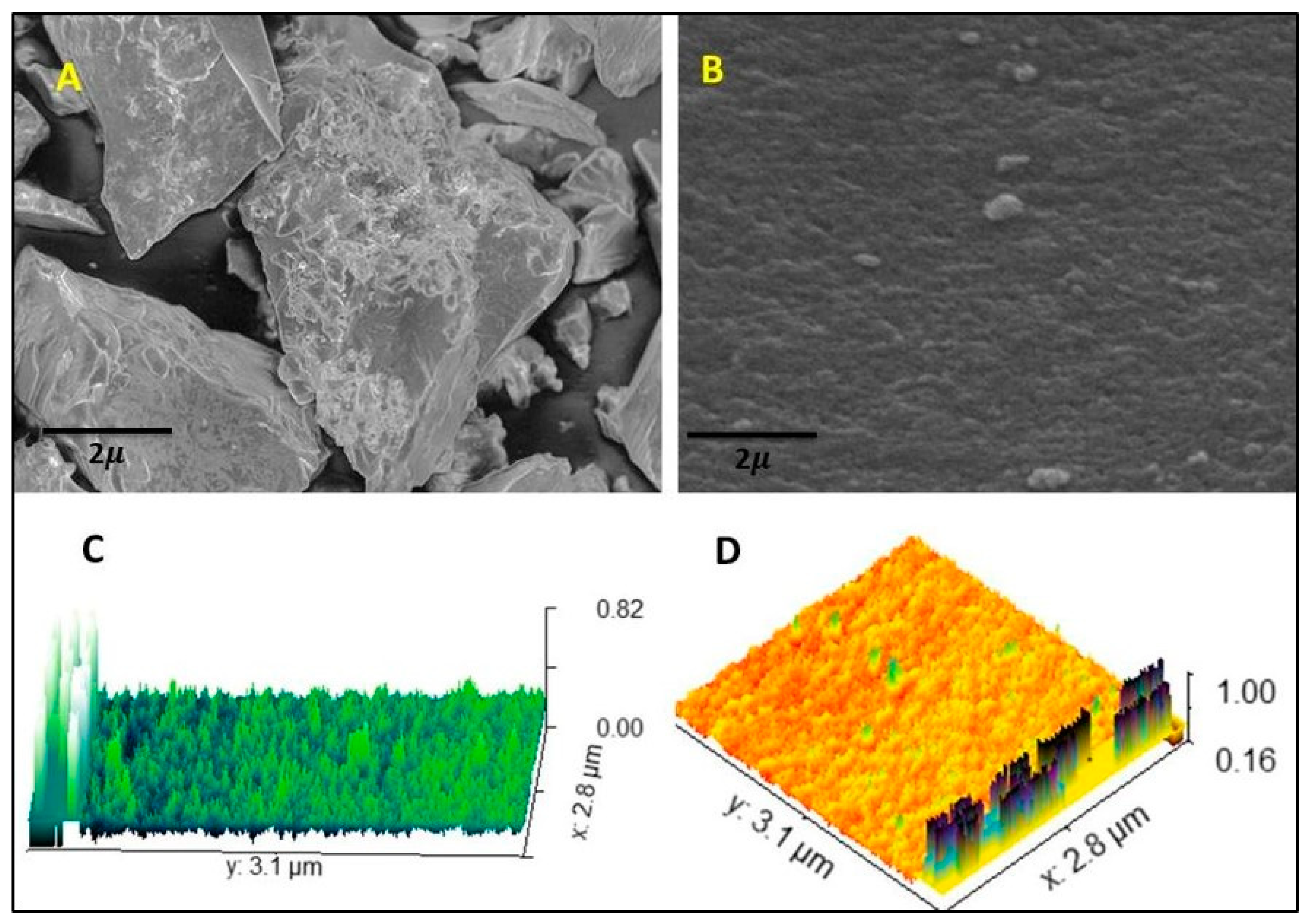
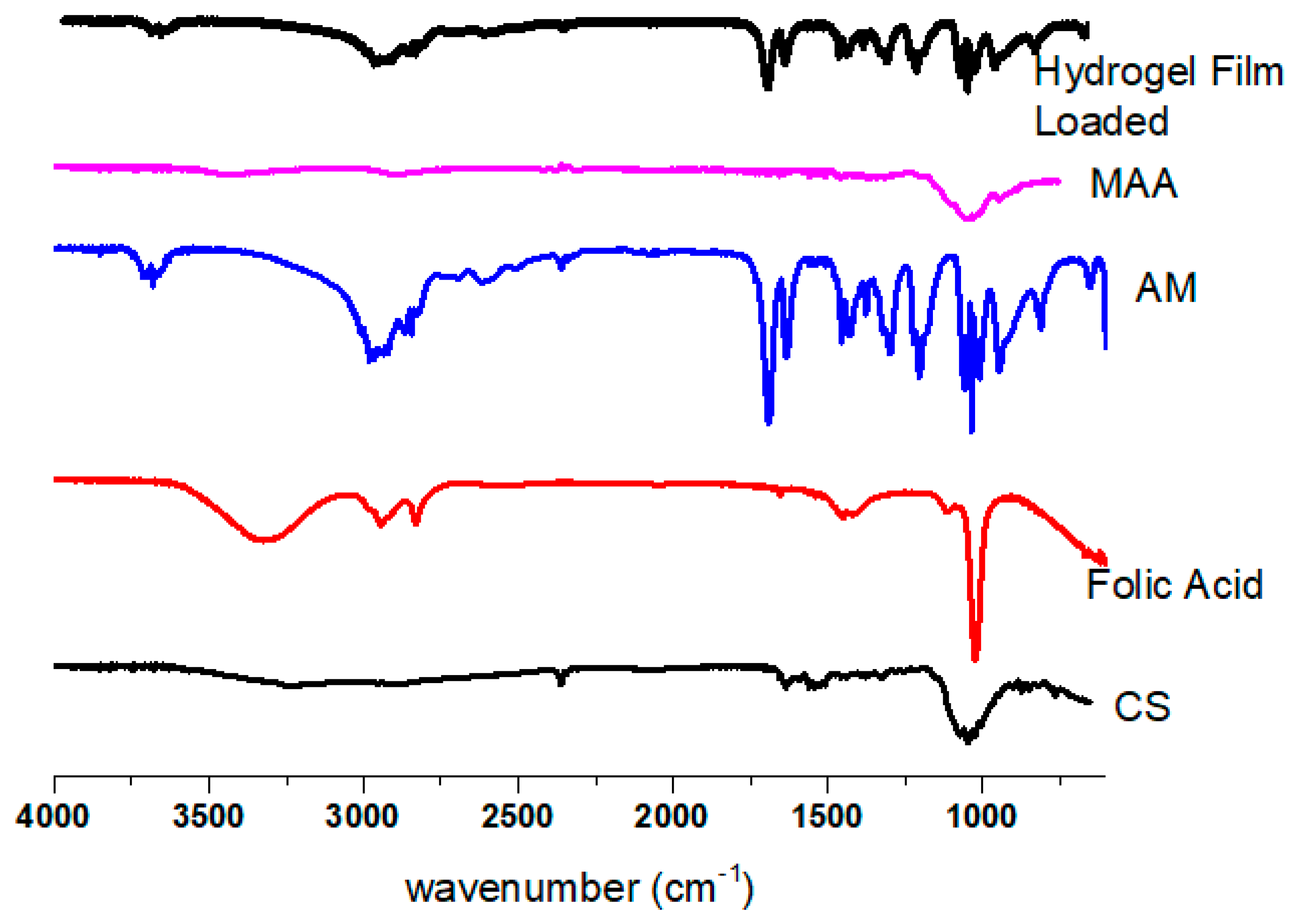
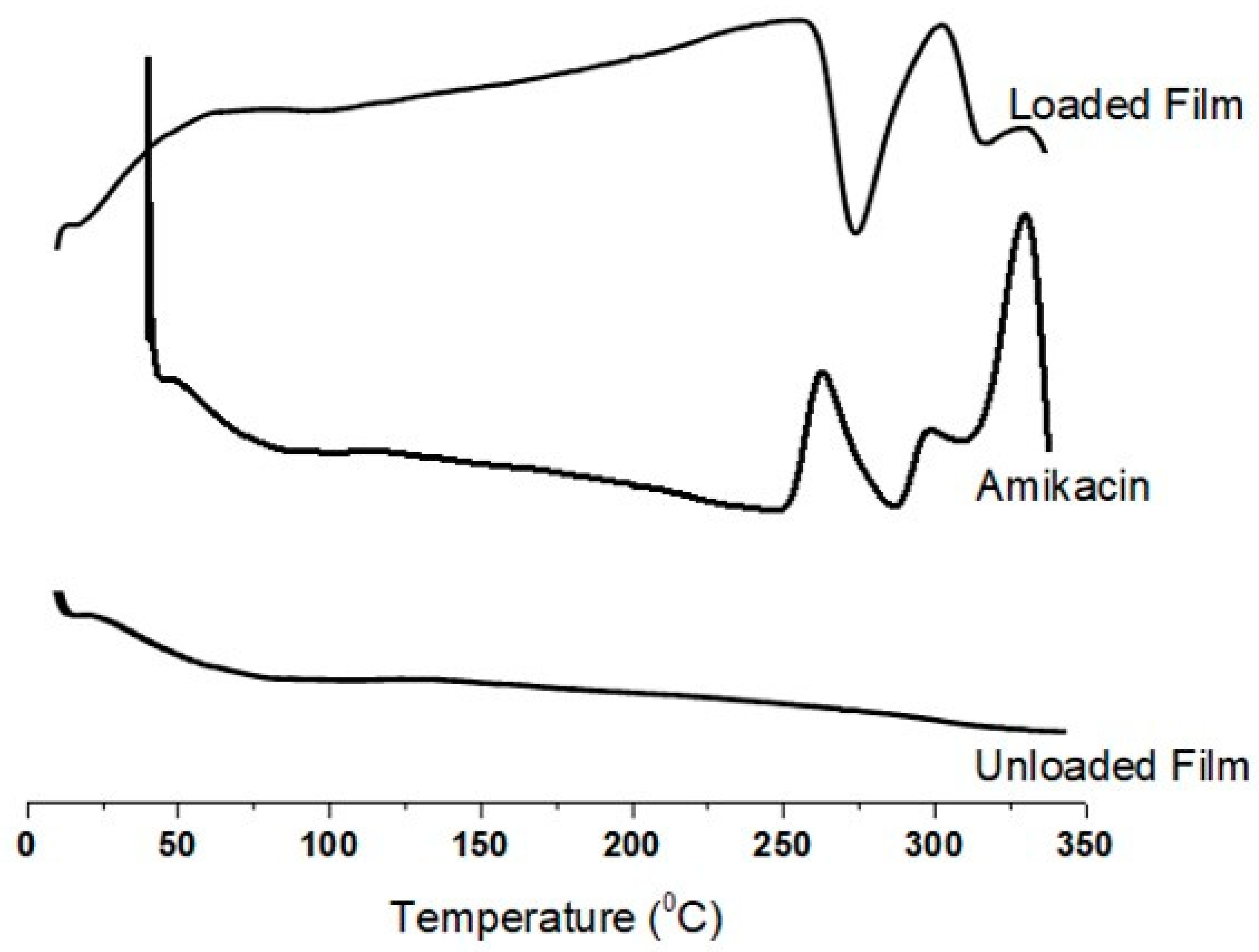
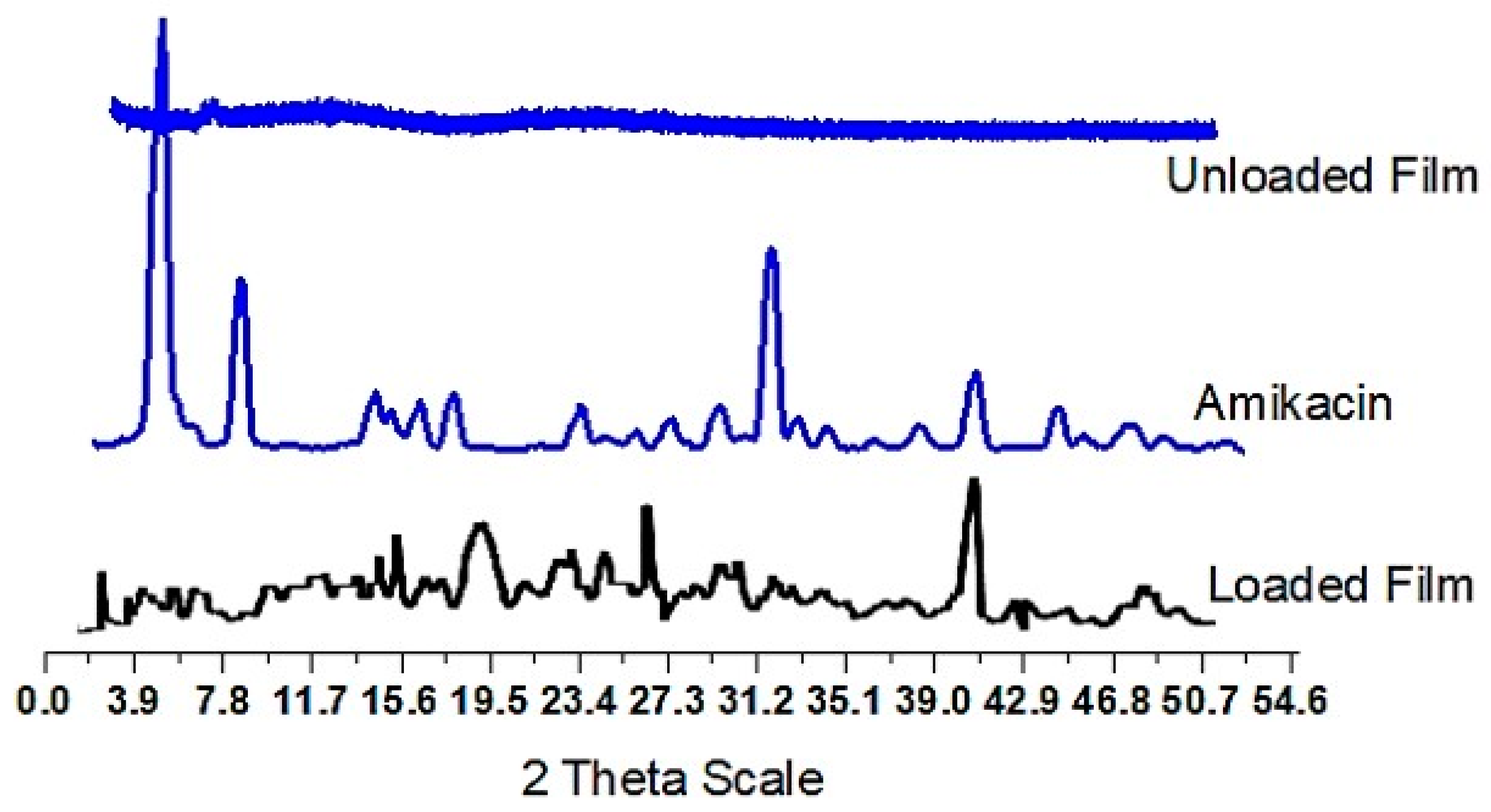
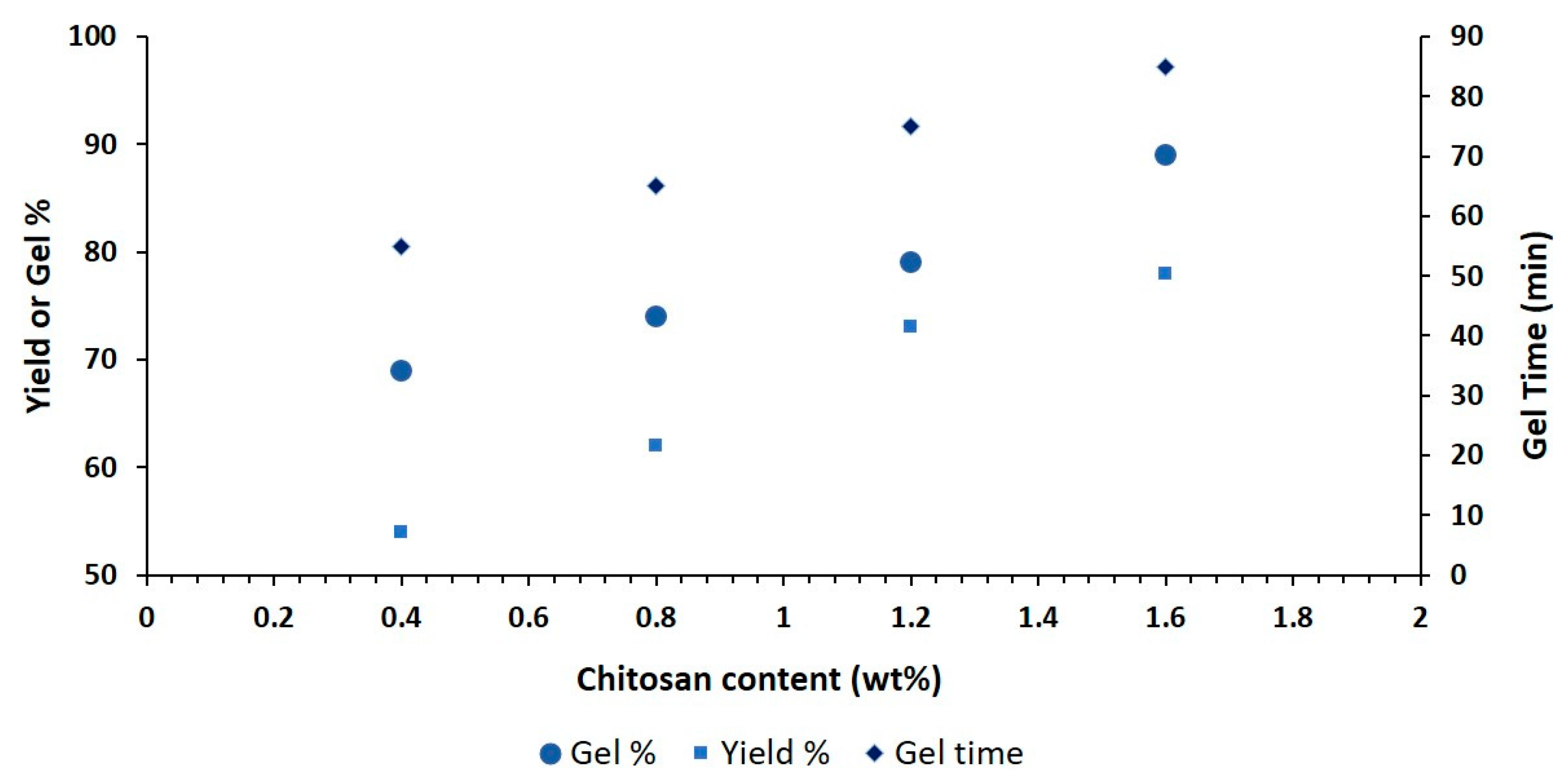
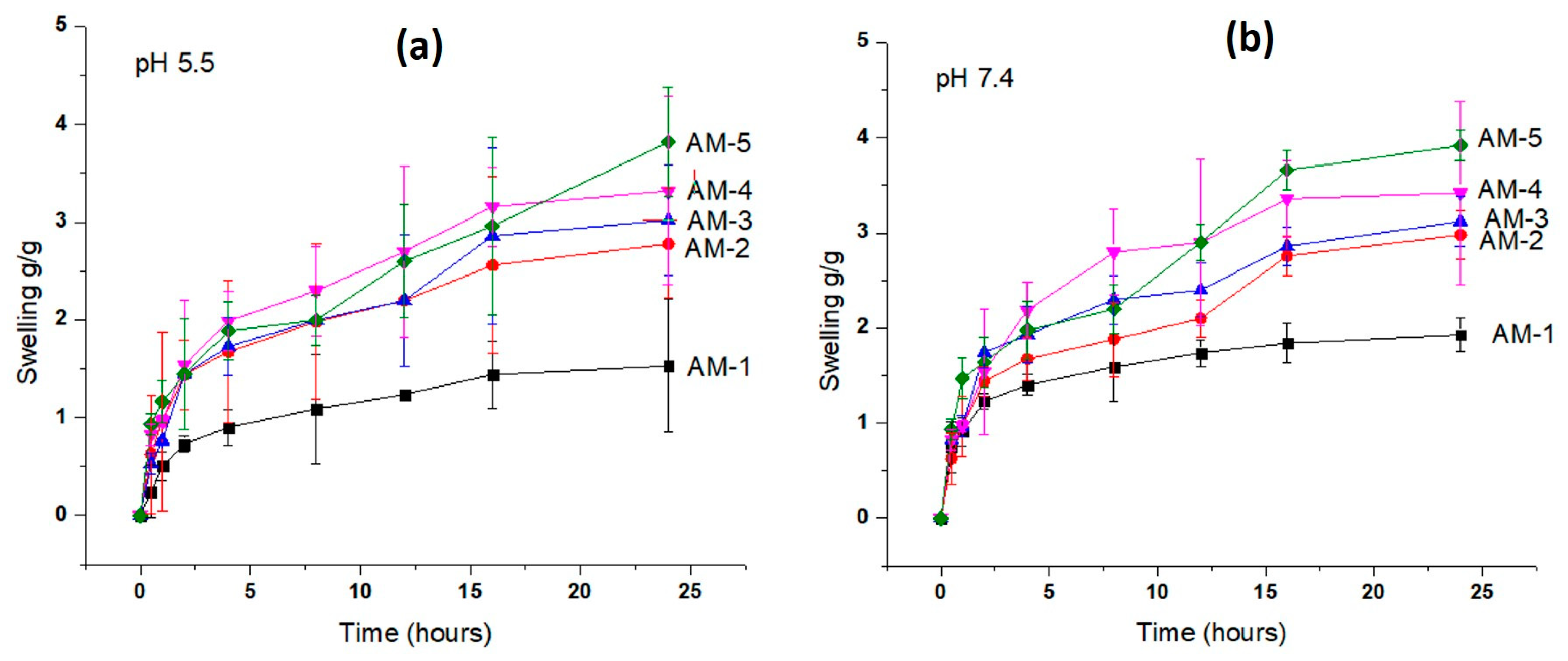
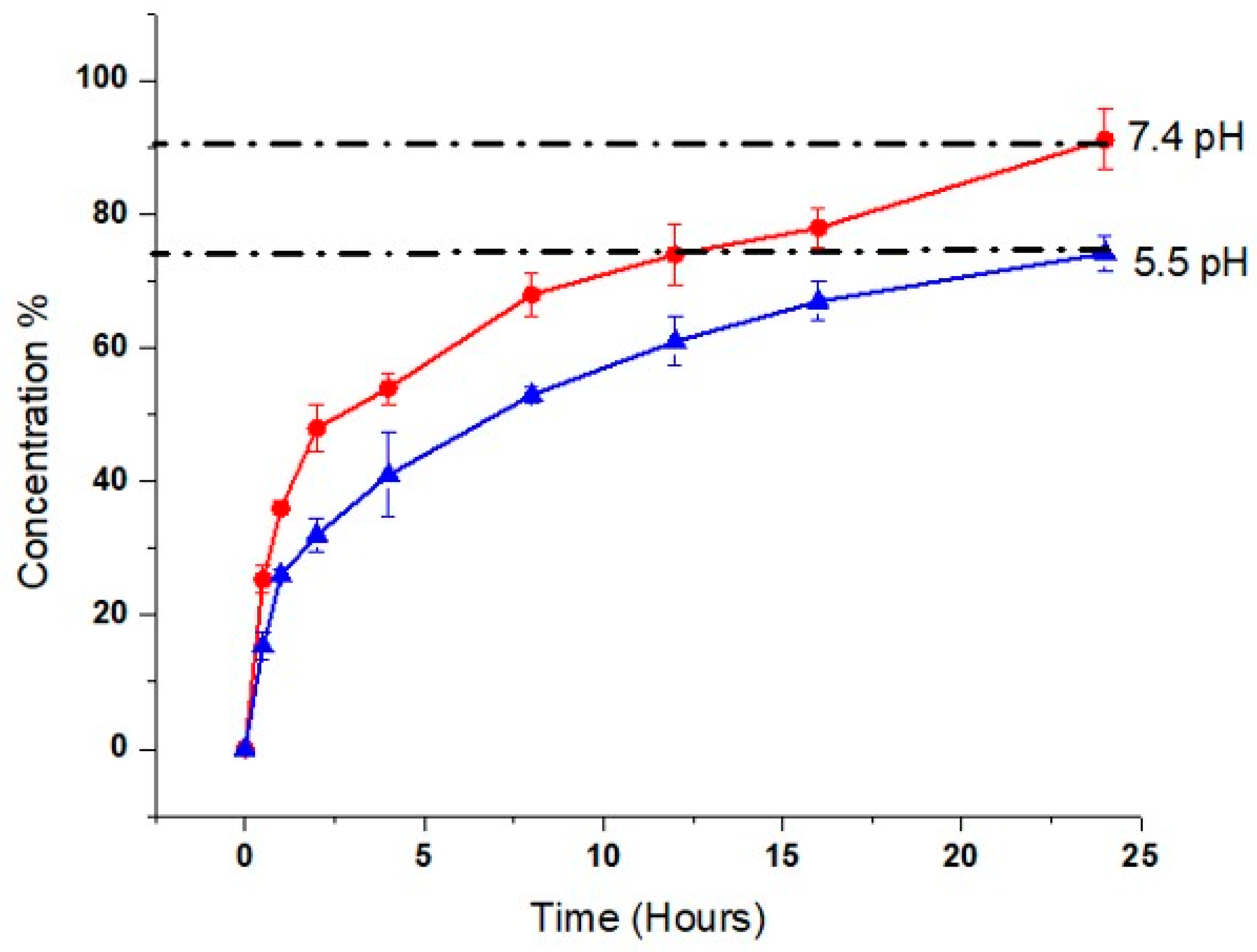
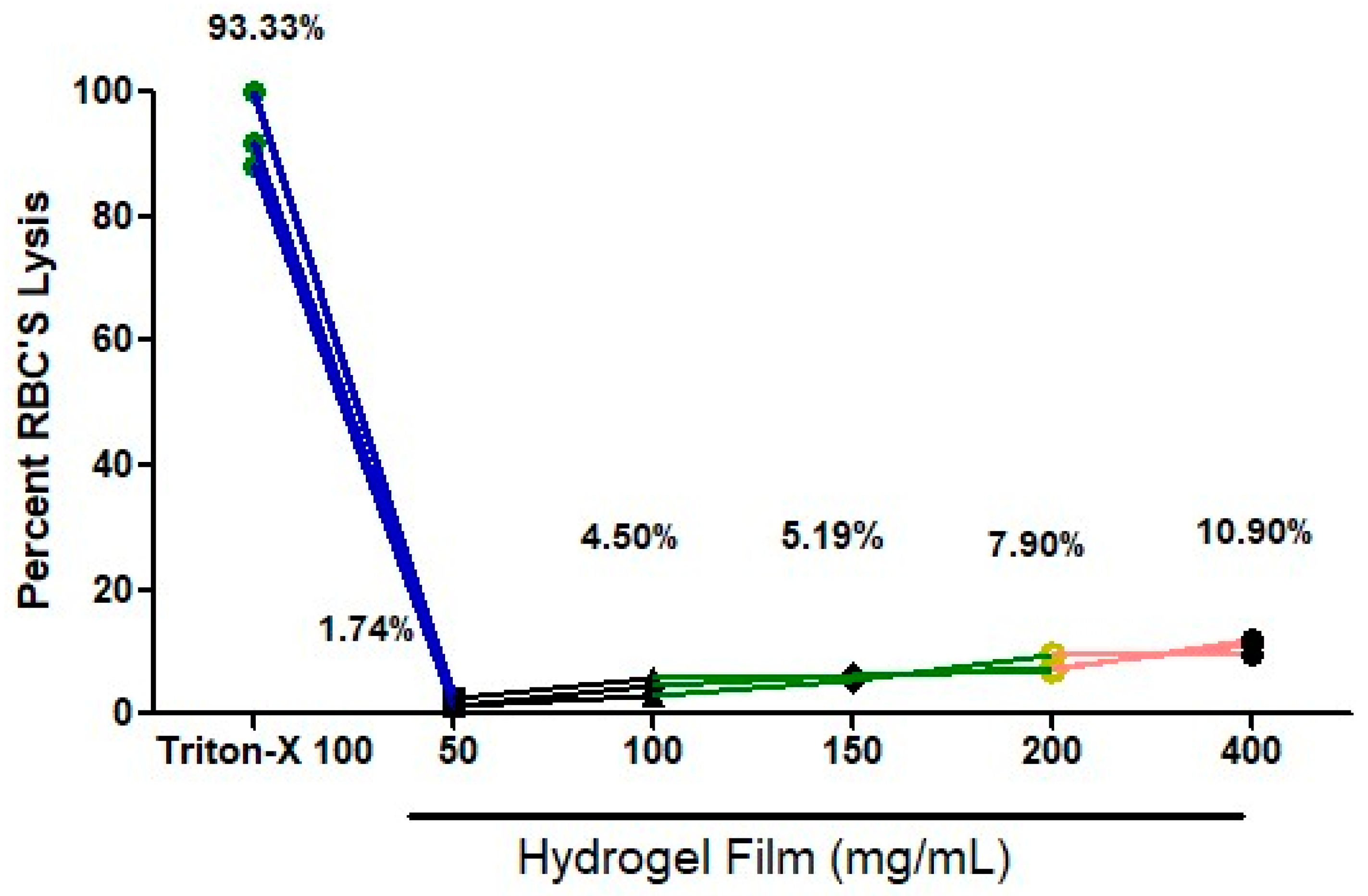



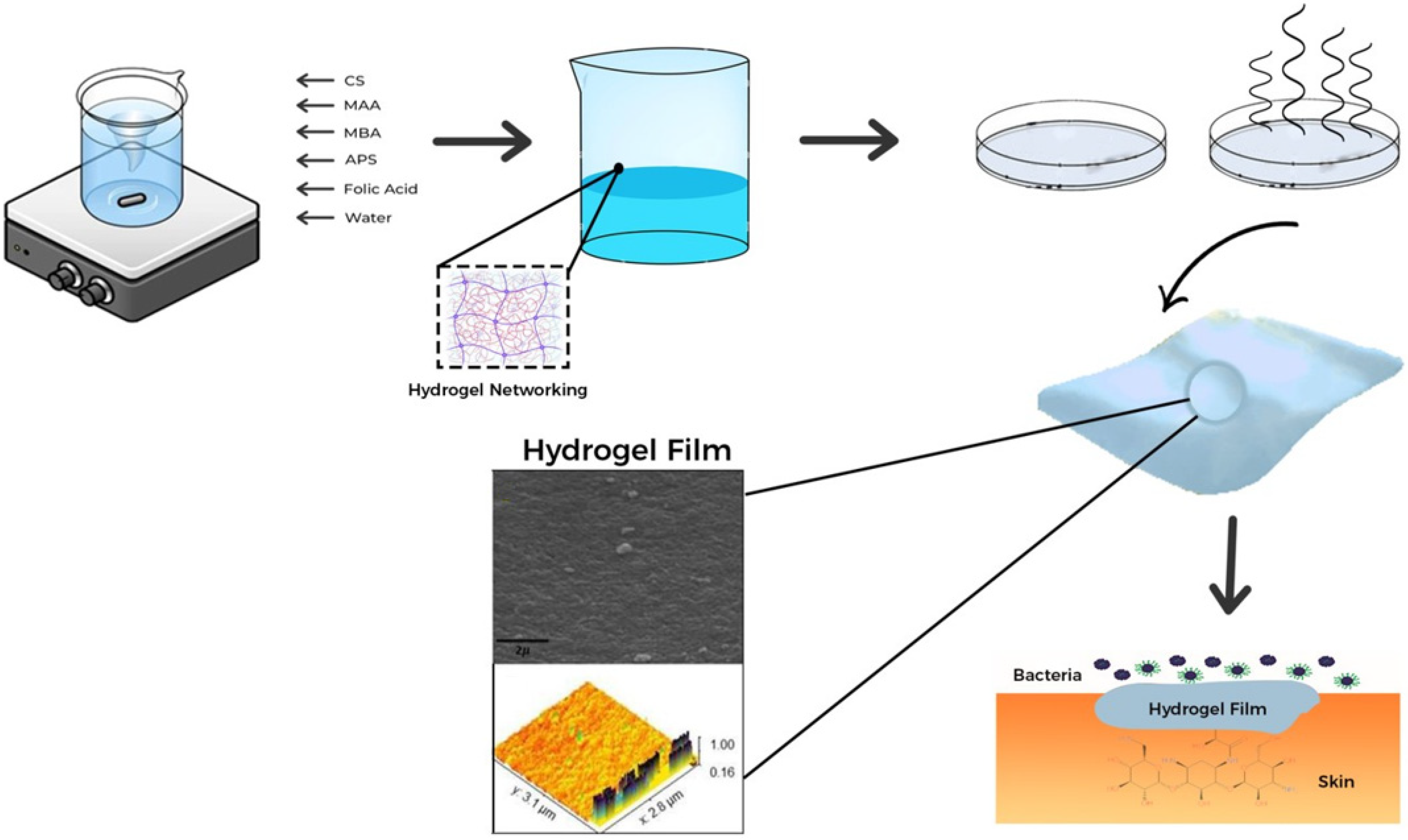
| Formulation Code | Drug Entrapment Efficiency % |
|---|---|
| AM-1 | 54.21 ± 1.51 |
| AM-2 | 59.12 ± 1.36 |
| AM-3 | 63.31 ± 1.21 |
| AM-4 | 71.36 ± 1.41 |
| AM-5 | 91.81 ± 1.36 |
| Formulation | Thickness (mm) | Weight Variation (g) | Folding Endurance | Moisture Content % | Moisture Uptake % |
|---|---|---|---|---|---|
| AM-1 | 0.042 ± 0.02 | 0.432 ± 0.08 | 340 ± 11 | 13.10 ± 1.12 | 13.10 ± 1.31 |
| AM-2 | 0.051 ± 0.03 | 0.471 ± 0.19 | 359 ± 10 | 13.70 ± 1.23 | 14.10 ± 1.42 |
| AM-3 | 0.059 ± 0.05 | 0.522 ± 0.07 | 410 ± 19 | 15.20 ± 1.34 | 15.10 ± 1.42 |
| AM-4 | 0.062 ± 0.02 | 0.512 ± 0.04 | 430 ± 13 | 16.10 ± 1.16 | 16.10 ± 1.32 |
| AM-5 | 0.074 ± 0.04 | 0.416 ± 0.29 | 490 ± 11 | 16.80 ± 1.27 | 16.70 ± 1.23 |
| Code | Drug Entrapment Efficiency | Percent Release (for a 24 h Period) | |
|---|---|---|---|
| pH 5.5 | pH 7.4 | ||
| AM-1 | 54.21 | ||
| AM-2 | 59.12 | ||
| AM-3 | 63.31 | ||
| AM-4 | 71.36 | ||
| AM-5 | 91.81 | 74.23 ± 1.7 | 90.21 ± 1.2 |
| Time (h) | Positive (Control) | Hydrogel Film | Negative |
|---|---|---|---|
| 24 | No | No | No |
| 48 | Yes | No | No |
| 72 | Yes | No | No |
| Zone of Inhibition (mm) | ||
|---|---|---|
| Assay # | Reference solution | AM-5 solution |
| 1 | 20.42 | 20.53 |
| 2 | 20.62 | 20.72 |
| Average | 20.52 | 20.62 |
| % Assay | Limit% 90–110 | |
| Calculation | ||
| Reference solution (A1) | 20.62 | |
| AM-5 solution (A2) | 20.52 | |
| Weight of reference stand (W) | 72.20 | |
| AM-5 film mixed in water (V) | 2.00 mL | |
| Potency of reference (P) | 692.50 μg/mg | |
| % assay of amikacin | 99.51% ± 2.00% | |
| Formulation | Thickness (mm) | Weight Variation (g) | Folding Endurance | Moisture Content % | Moisture Uptake % |
|---|---|---|---|---|---|
| AM-5 | 0.078 ± 0.14 | 0.496 ± 0.21 | 499 ± 12 | 16.93 ± 1.87 | 16.97 ± 1.13 |
| Formulation Code | Chitosan wt% | Folic Acid wt% | MAA wt% | APS wt% | MBA wt% | AM mg |
|---|---|---|---|---|---|---|
| AM-1 | 0.4 | 0.4 | 20 | 0.32 | 0.1 | 500 |
| AM-2 | 0.8 | 0.4 | 20 | 0.32 | 0.1 | 500 |
| AM-3 | 1.2 | 0.4 | 20 | 0.32 | 0.1 | 500 |
| AM-4 | 1.6 | 0.4 | 20 | 0.32 | 0.1 | 500 |
| AM-5 | 2.0 | 0.4 | 20 | 0.32 | 0.1 | 500 |
Disclaimer/Publisher’s Note: The statements, opinions and data contained in all publications are solely those of the individual author(s) and contributor(s) and not of MDPI and/or the editor(s). MDPI and/or the editor(s) disclaim responsibility for any injury to people or property resulting from any ideas, methods, instructions or products referred to in the content. |
© 2023 by the authors. Licensee MDPI, Basel, Switzerland. This article is an open access article distributed under the terms and conditions of the Creative Commons Attribution (CC BY) license (https://creativecommons.org/licenses/by/4.0/).
Share and Cite
Mehmood, Y.; Shahid, H.; Arshad, N.; Rasul, A.; Jamshaid, T.; Jamshaid, M.; Jamshaid, U.; Uddin, M.N.; Kazi, M. Amikacin-Loaded Chitosan Hydrogel Film Cross-Linked with Folic Acid for Wound Healing Application. Gels 2023, 9, 551. https://doi.org/10.3390/gels9070551
Mehmood Y, Shahid H, Arshad N, Rasul A, Jamshaid T, Jamshaid M, Jamshaid U, Uddin MN, Kazi M. Amikacin-Loaded Chitosan Hydrogel Film Cross-Linked with Folic Acid for Wound Healing Application. Gels. 2023; 9(7):551. https://doi.org/10.3390/gels9070551
Chicago/Turabian StyleMehmood, Yasir, Hira Shahid, Numera Arshad, Akhtar Rasul, Talha Jamshaid, Muhammad Jamshaid, Usama Jamshaid, Mohammad N. Uddin, and Mohsin Kazi. 2023. "Amikacin-Loaded Chitosan Hydrogel Film Cross-Linked with Folic Acid for Wound Healing Application" Gels 9, no. 7: 551. https://doi.org/10.3390/gels9070551
APA StyleMehmood, Y., Shahid, H., Arshad, N., Rasul, A., Jamshaid, T., Jamshaid, M., Jamshaid, U., Uddin, M. N., & Kazi, M. (2023). Amikacin-Loaded Chitosan Hydrogel Film Cross-Linked with Folic Acid for Wound Healing Application. Gels, 9(7), 551. https://doi.org/10.3390/gels9070551








